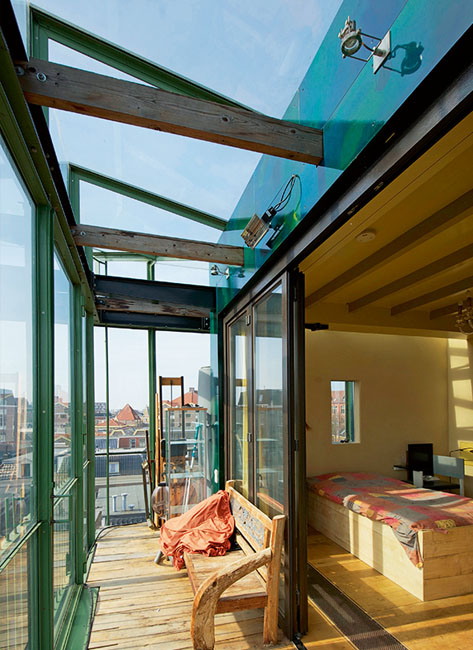Hoogland Living-Working House
DAAD Architects & Eric de Leeuw
Abstract
In 1997, Wouter Hoogland and Hannah Versteegh bought a house on the Stationsstraat in Groningen, the garden of which was connected to a shed on the Gedempte Zuiderdiep. They wanted to build a dwelling on the Zuiderdiep, while keeping the shed as a horse stable and garage for their motorbike. DAAD came up with a simple concept: continue the garden over the roof of the shed and place the dwelling on columns above this roof garden. That way, the view from the Zuiderdiep of an old tree in the garden would be guaranteed.
The dwelling itself is a three-storeyed glass turret with a wooden core that contains the living functions. The supporting construction consists of four steel columns that continue through to the foundation. The outer shell around the wooden core, comprised of single glazing encased in steel profiles, contains the stairs, a walkway and lavatory. In the wintertime the residents withdraw into the heated core; in the springtime the doors to the sun lounge can be opened and in the summertime the glass outer shell can open up so as to live entirely outdoors. Planter boxes are built into the façade so that ivy can provide shade during the summer. With an eye towards the position of the sun and the view, the residents furnished the space in the sun lounge for several different purposes, such as reading the paper in the morning sunlight or enjoying the panorama of the city in the evening and morning light by opening the doors of the box bed. Thanks to the buffering effect of the temperate climate in the sun lounge and the residents’ withdrawal to the core in the winter, the house hardly uses any energy.
The clients wanted to build the house themselves in order to have the time to think more about the project and work on the layout and detailing. On the basis of a few sketches of the concept, some simple ground plans and a small model, a building permit was applied for and obtained. In order to ensure that the house complied with all building regulations, an official from the building and housing inspection department came by every week during the roughly ten years that construction lasted. The architects also stopped by all those years, discussing the latest results and solving problems, but above all witnessing solutions being found that the firm would never have thought of themselves.



